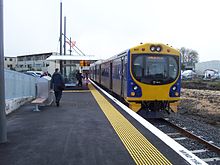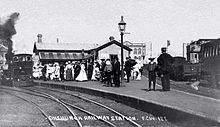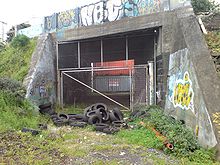- Onehunga Branch
-
Onehunga Branch
ADL 807 at the new Onehunga railway station, at the terminus of the branchOverview Type Urban rail Status Open Termini Penrose
Onehunga StationStations 3 Daily ridership 1200/day[1] Operation Opened December 1873
Reopened September 2010Closed 1973 (for passenger trains)
2006 (for freight trains)Owner KiwiRail Network Operator(s) Veolia Character Urban Rolling stock ADL class Technical Line length 3.6 km (2.2 mi)[2] No. of tracks Single Track gauge 1,067 mm (3 ft 6 in) Electrification 25kV under construction Route map Legend

North Auckland Line 





00 km Penrose 

North Auckland Line 

O'Rorke Rd 



Maurice Rd 

Mays Rd 

1.95 km Te Papapa 

Captain Springs Road 

Church St 

3.32 km Onehunga 

Neilson St 

3.20 km State Highway 20 

3.41 km Onehunga Wharf The Onehunga Branch railway line is located in Auckland, New Zealand. The line was constructed by the Auckland Provincial Government and opened from Penrose to Onehunga on 24 December 1873, and extended to Onehunga Wharf on 28 November 1878. It is 3.6 kilometres (2.2 mi) in length.[2]
After being closed to passenger traffic in 1973, and fully mothballed in 2007, the line was reopened on 18 September 2010, with regular passenger services beginning on 19 September 2010.[2][3]
Contents
History
Original construction and services
The Onehunga Branch was one of the first government-funded railways in New Zealand. Along with a further 10 km north to Auckland (now part of the North Auckland Line and the Auckland–Newmarket Line), the Onehunga Branch was the first operating section of the railways in the North Island. Construction had begun in 1865 under the auspices of Auckland's provincial government, to international standard gauge, 1,435 mm (4 ft 8 1⁄2 in), but due to a lack of funds and disputes between the government and the contractors building the line, construction stalled two years later. The line featured in Julius Vogel's 1870 Great Public Works programme and construction resumed in 1872, with to New Zealand's newly accepted national narrow gauge of 1,067 mm (3 ft 6 in). With the dissolution of the provinces of New Zealand, the line was integrated into the state-run system on the creation of the New Zealand Railways Department.[4]
Connecting the Port of Onehunga with the Port of Auckland via Penrose, the branch line became a busy link between the two harbours of the rapidly expanding city. Onehunga was a busy port despite its treacherous harbour entrance, and was well served by coastal shipping, some of which plied to New Plymouth. With the completion of the Wellington and Manawatu Railway Company's railway line in 1886, passengers from Auckland to Wellington rode a "Boat Train" from Auckland to Onehunga, connected with a steamer to New Plymouth, then the New Plymouth Express to Wellington. The boat trains ran to the wharf and in 1878 a small station was sited there and remained in use until 1927. By 1897 there were 14 trains daily, both passenger trains and mixed trains. In 1903 an electric tram was introduced between Auckland and Onehunga running along Manukau Road, and it dealt a severe blow to passenger patronage on the branch. The boat trains finished in the 1920s and the through service from Auckland to Onehunga in 1950, but passenger services from Penrose ran until April 1973. The line then served local industries until it was mothballed. Freight shunts continued to operate as far as Mays Rd until late 2007 and an annual enthusiast excursion with ADL class DMU ran until 2006. Three visits by the RM class Silver Fern railcars occurred in 1996, 1999 and 2000. The last steam powered train to operate on the line before closure was a series of excursions over Labour Weekend 1993 with a tank engine and carriages from Glenbrook Vintage Railway. JA 1275 ran shuttle trains with DC 4536 on 18 September 2010 to celebrate the reopening of the line, before regular passenger services commenced the next day.
The original Onehunga Railway Station was on the corner of Princes Street and Onehunga Mall. The old station building has been relocated to 38 Alfred Street, not far away, and is owned by the Railway Enthusiasts Society and used as their clubrooms and a railway museum. Other stations on the line were at Te Papapa and Onehunga Wharf.
2010 reopening
The campaign to reopen the line was first launched by Auckland Regional Council (ARC) councillor Mike Lee in mid 2002. The cause was then taken up by Campaign for Better Transport. Lee and CBT's concept was to rebuild the line, with new stations at Mt Smart, Te Papapa and Onehunga, and in mid 2006 CBT had received 8,000 signatures on a petition to reopen the line.[5]
The petition was presented to the ARC, which formally endorsed it and passed it to its subsidiary, ARTA, recommending that rail passenger services should be started to both Onehunga and to Helensville. The petition was later handed back by ARTA to the ARC, with ARTA stating that the track was the responsibility of government track organisation, ONTRACK (now called KiwiRail Network). The petition was then presented to Parliament's Transport and Labour Relations Select Committee by Mike Lee as Chairman of the Auckland Regional Council. On 13 March 2007 the Government announced that it had given approval for ONTRACK to spend $10 million on reopening the line for passengers and freight. As part of the rehabilitation work a private siding was built at the Owens Truck Depot.[6]
In August 2007 coastal shipping firm Pacifica Shipping called for the section of the line between Onehunga Wharf and the end of the line at Port of Onehunga to be reopened,[7] to allow for export freight from the South Island to be unloaded at the wharf and transferred by rail to the Port of Auckland on the Waitemata Harbour. Currently the freight is carried by road to the port, leading to delays due to traffic. A full freight service reopening could potentially remove around 200 containers to and 250 containers from the port per week from the local streets.[8]
As of 2009, the locations of new stations on the branch were still to be determined by ARTA and ONTRACK.[9] It was also unclear as of May 2009 whether the reopened line would reach as far as Onehunga Mall (as originally planned) and it was noted that continuation to the Port of Onehunga would depend on Ports of Auckland's willingness to fund a terminal within their land.[10] However, detailed design for the Te Papapa and Mount Smart stations was underway.[11]
On 24 June 2009 ARTA and the New Zealand Transport Agency (NZTA) agreed to jointly fund three new stations on the branch – Mt Smart, Te Papapa and Onehunga (on the site of the ITM, 109-113 Onehunga Mall). The NZTA was to pay 60% of the $3.9 million cost of building the stations.[12]
In mid 2010, construction started on the last station, at Onehunga, and its opening was delayed past its intended date to September 2010. Concern was raised that the new station would not be able to take three-car trains due to its short length, but ARTA spokespeople responded by noting that initial usage predictions did not require three-car trains, and that the length of the platform could be extended later, though new consents would be needed in that case.[3]
On Saturday 18 September, reopening ceremonies were held, with Sunday 19 September being the first day of normal passenger services. In total, the cost of reopening the line was about $21.6 million, of which KiwiRail came up with $10 million for the track work and the Auckland Regional Transport Authority with $3.6 million to create three stations. Auckland Regional Council also used $8 million to buy the site for the Onehunga station, where a 60 spaces park & ride facility is to open one week after the train services began.[13]
Patronage on the line quickly grew to respectable levels, being at 1200 passengers a day in mid 2011.[1]
Potential future extension
Extension of the line to Auckland International Airport has been proposed. The main barrier has been crossing Manukau Harbour between Onehunga and Mangere Bridge. Transit New Zealand, the government entity charged with building and maintaining state highways, has announced that a bridge across the harbour will be designed to accommodate a rail link.[14] In September 2007 ARTA announced that it was willing to pay Transit New Zealand $2.5 million to "future-proof" the duplication of the Manukau harbour crossing in order "to accommodate a passenger rail connection."[15] The bridge as then built to accommodate this, and NZTA has provided for a rail corridor near the motorway as far as Walmsley Road.[1]
There is a proposal to build an Avondale–Southdown line, connecting the North Auckland Line (the MAXX Western line) near Avondale to Auckland Freight Centre at Southdown. KiwiRail Network owns most of the corridor, which leaves the North Auckland Line east of Avondale station and follows Oakley Creek and the SH20 Waterview Connection motorway corridor (construction of which is to make provision for the rail line's construction).[16]
Another proposal exists to connect the Onehunga Branch at Galway Street to the Avondale–Southdown line by building a tunnel under Onehunga Mall to meet Hugh Watt Drive (State Highway 20) before connecting to the proposed route at Hillsborough.[17]
References
- ^ a b c "Stuck in traffic". The New Zealand Herald. http://www.nzherald.co.nz/nz/news/article.cfm?c_id=1&objectid=10730146. Retrieved 12 July 2011.
- ^ a b c Dearnaley, Mathew (12 May 2010). "ARC chief unhappy at delay to new service". The New Zealand Herald (Auckland: APN Holdings NZ). http://www.nzherald.co.nz/rail/news/article.cfm?c_id=296&objectid=10644332.
- ^ a b "Auckland platform woes can be fixed - ARTA". The New Zealand Herald. 8 July 2010. http://www.nzherald.co.nz/nz/news/article.cfm?c_id=1&objectid=10657363. Retrieved 8 July 2010.
- ^ Geoffrey B. Churchman and Tony Hurst, The Railways of New Zealand: A Journey Through History (Auckland: HarperCollins, 1991), 101.
- ^ "Work starts at new Onehunga rail station". The New Zealand Herald. 21 April 2010. http://www.nzherald.co.nz/nz/news/article.cfm?c_id=1&objectid=10639743. Retrieved 16 January 2011.
- ^ "Onehunga rail upgrade gets green light". The Beehive. 13 March 2007. http://www.beehive.govt.nz/ViewDocument.aspx?DocumentID=28632. Retrieved 2007-09-01.
- ^ Heather McCracken (2007-08-08). "Firm floats port rail plan". Auckland Central Leader. http://www.stuff.co.nz/auckland/4156198a6016.html. Retrieved 2007-09-01.
- ^ "Rail freight studied for Onehunga". The New Zealand Herald. 2007-08-16. http://www.nzherald.co.nz/topic/story.cfm?c_id=296&objectid=10457947.
- ^ Phoebe Falconer (14 April 2009). "Revamped rail link will lead to airport service". New Zealand Herald. http://www.nzherald.co.nz/transport/news/article.cfm?c_id=97&objectid=10566417. Retrieved 2009-04-12.
- ^ Dearnaley, Mathew (5 May 2009). "Train plans on track, Onehunga told". The New Zealand Herald. http://www.nzherald.co.nz/transport/news/article.cfm?c_id=97&objectid=10570446. Retrieved 1 November 2011.
- ^ Monthly Business Report, March 2009 (from ARTA. Accessed 2009-05-10.)
- ^ Rhiannon Horrell (24 June 2009). "Action on Onehunga line". Central Leader. http://www.stuff.co.nz/auckland/local-news/central-leader/2526884/Action-on-Onehunga-line. Retrieved 2009-09-24.
- ^ "Rail link puts fun back into getting to school". The New Zealand Herald. 21 September 2010. http://www.nzherald.co.nz/nz/news/article.cfm?c_id=1&objectid=10674952. Retrieved 22 September 2010.
- ^ "Transit opens door to cross-harbour rail link to airport". New Zealand Herald. 9 February 2007. http://subs.nzherald.co.nz/organisation/story.cfm?o_id=223&objectid=10423101.
- ^ "$2.5m offer to link Auckland airport to Britomart". New Zealand Herald. 2007-09-07. http://www.nzherald.co.nz/section/1/story.cfm?c_id=1&objectid=10462204&ref=rss. Retrieved 2007-09-07.
- ^ "Evidence of Pamela Marie Butler on behalf of KiwiRail". KiwiRail / Environmental Protection Authority. 17 December 2010. http://www.epa.govt.nz/applications/waterview/evidence-transcripts/submitter-evidence/164-2-kiwi-rail-butler-pamela-statement-of-evidence.pdf. Retrieved 15 January 2011.
- ^ "Maungakiekie Area Plan". Auckland City Council. http://www.itsmybackyard.co.nz/areaplans/docs/maungakiekie.pdf. Retrieved 2009-04-14.[dead link]
External links
Categories:- Railway lines in New Zealand
- Public transport in Auckland
Wikimedia Foundation. 2010.



